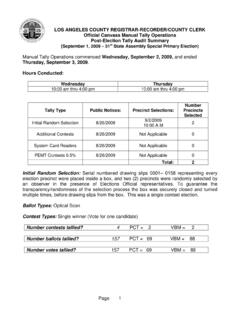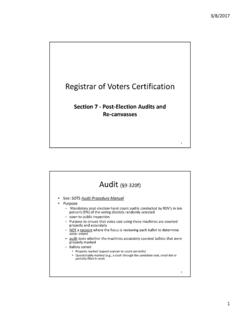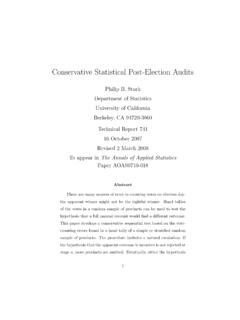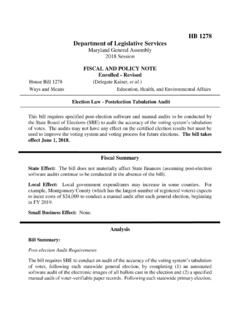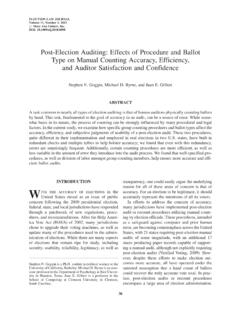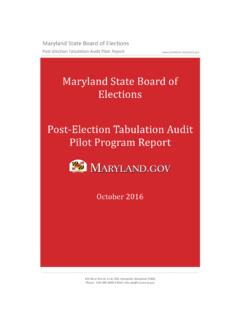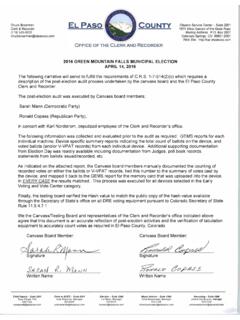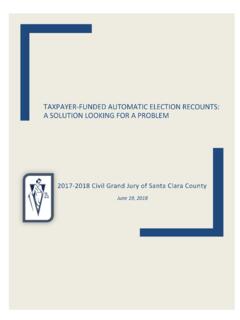Transcription of Post-Election Audit Standards Working Group Report ...
1 Post-Election Audit Standards Working Group Report Evaluation of Audit Sampling Models and Options for Strengthening California s Manual Count July 27, 2007 iPost- election Audit Standards Working Group The Working Group was comprised of the following experts in the fields of computer science, financial auditing, statistical analysis, election reform advocacy, and city and county government. o David Jefferson (Chairperson), Center for Applied Scientific Computing, Lawrence Livermore National Laboratory o Elaine Ginnold, Registrar of Voters, Marin County o Kathleen Midstokke, City Clerk, City of Downey o Kim Alexander, President, California Voter Foundation o Philip Stark, Professor of Statistics, University of California, Berkeley o Amy Lehmkuhl, Certified Public Accountant, Ueltzen & Company, LLP iiTable of Contents Executive Summary 1 1. California Law and the Purpose of Post-Election Auditing 4 2.
2 Auditing Principles 5 3. Sampling Models: Fixed and Adjustable Sample Sizes and Their Variations 7 Fixed Number or Percentage of Precincts 9 Adjusting the Number of Precincts to Audit 10 Tiered Audits 11 Adjusting Sample Size to Detect Error 12 Adjusting Sample Size to Estimate the Total Error 14 Other Approaches 15 Complete Recount for Close Races 15 Additional Auditing of High-Risk Machines or Systems 15 Targeted Selection of Additional Precincts 16 Changing the Unit of Audit 16 Polling Audit Model 16 Ballot Sampling 17 Machine-Aided Audit 18 4. Discrepancies and Escalation of the Audit 18 Classification of the Causes of Discrepancies 19 Handling of Discrepancies 19 Resolving and Reporting Discrepancies 20 Verifying That Races Have Been Called Correctly; Escalating the Audit 20 Investigating and Correcting Systematic Hardware, Software, and Procedural Problems 22 5.
3 Random Selection of Precincts 22 6. Additional Options to Improve the Manual Count 23 7. Increasing the Transparency of the Manual Count and the Post-Election Process 24 8. Public and Poll Worker Education About the Voter Verified Paper Audit Trail 25 iii9. Recommendations for Further Study 26 Appendix I: Definitions 28 Appendix II: Common Errors That Cause Discrepancies 29 Appendix III: Bibliography 30 Appendix IV: Testimony and Oral Consultation 32 Appendix V: Post-Election Audit Standards Working Group Charter 33 1 Executive Summary Auditing is one of the most important tools for verifying election results and checking the accuracy and reliability of voting systems. If audits are effective, then the public can have confidence in the outcome of elections even if the voting systems used are imperfect, because the Audit can detect and be used as the basis to help correct human and voting system California law requires a manual count of 1% of precincts in every election .
4 This Report evaluates new models for determining the appropriate size of the sample for the manual count, examines escalation ( , expansion) of audits when discrepancies are found between the manual and machine counts, and provides options for strengthening California s manual count. The following are important rules of thumb to keep in mind when considering the manual count: o The larger the random sample, the more likely it is that human and voting system errors will be detected. o Close races require larger random samples to determine whether errors could overturn election results. o Races involving a small number of precincts require a larger percentage random sample to determine whether errors could overturn election results. The Working Group has reached a consensus that the most effective way to conduct Post-Election audits is to take a risk-based approach. The sampling model that works best for this approach is the adjustable sample model, where the size of the initial random sample depends on a number of factors, including the apparent margin of victory, the number of precincts, the number of ballots cast in each precinct, and a desired confidence level ( , 99%) that the winner of the election has been called correctly.
5 Unfortunately, the statistical models that exist for determining the size of the random sample do not apply to California, because they require the random sample to be selected from the state as a whole. In California, cities, counties, and special districts draw independent random samples. These models do not currently take into account overvotes and undervotes, nor do they cover multi-winner elections. Moreover, the approaches that exist give confidence in the outcome of the election only if no discrepancies are found. Still lacking is a method that can determine whether to trust the outcome of the election when small discrepancies are found. The Working Group recommends that the Secretary of State develop a comprehensive approach to verifying election outcomes. Such an approach would involve a hand count of a minimum percentage of precincts for all races, and more precincts for close races and races involving only a small number of precincts.
6 The approach would specify an initial sample size and how the sample should be expanded if discrepancies are found. Ultimately the approach must be able to determine whether the outcome of each race is in doubt, given the discrepancies found by the hand count. 1 In the context of voting system auditability, experts describe this concept as "software independence." A software-independent voting system can be audited using a paper ballot or voter verified paper Audit trail (VVPAT). 2 Because developing and testing such an approach for California will take a significant amount of time, this Report suggests several short-term options for improving the existing manual count process and increasing the chances of detecting errors: o Increase the manual count sample size for close races. While this involves counting more precincts than the 1% required by law, it need only involve a manual count of the specific races on the ballot that have a narrow margin of victory not the entire ballot in those additional precincts.
7 O Increase the manual count sample size in jurisdictions that use high-risk voting systems. o Increase the manual count sample size in small counties. The Secretary might require small counties where current law requires only one precinct to be manually counted to Audit at least two precincts. o Consider targeted audits where candidates select additional precincts for the manual count in close races. While not a statistical approach, this may increase the subjective confidence of candidates and the public and can be used for specific races. o Escalate the manual count to investigate discrepancies that indicate a particular race may not have been called correctly or that a voting system malfunctioned. o Select precincts using a transparent method for generating random samples, such as rolling 10-sided dice. Methods that rely on computers are not transparent. o Establish uniform procedures for conducting the manual count, including procedures for chain of custody; requiring tracking of undervotes, overvotes, and cancelled Direct Record Electronic (DRE) ballots; blind counting; public reporting of discrepancies; and any escalation measures taken.
8 O Increase transparency of the manual count and Post-Election process by posting the dates the manual count will take place and posting discrepancy reports. Jurisdictions can increase transparency by improving public reporting and setting up election advisory committees, as for example Alameda, Humboldt, and Marin counties have done. o Educate voters who use DREs that it is crucial to check that their Voter-Verified Paper Audit Trail (VVPAT) is accurate. The VVPAT is only valuable as an auditing tool if the voter actually checks each vote printed on the VVPAT. Increases in Post-Election auditing must take into account the statutory 28-day canvass period and the limited resources available to local elections officials. Requiring a manual count of additional precincts or races beyond the 1% requirement will increase the burden on local elections officials. Many already find it difficult to complete their work in the time allotted.
9 Some counties have reported that a new law requiring absentee (also 3called Vote by Mail ) ballots to be included in the manual count has nearly doubled the time it takes to complete the manual count. Finally, because the manual count is only one of many methods elections officials use to ensure accurate election results, the Working Group recommends the Secretary of State establish a long-term Working Group including a number of city and county elections officials to study and develop statewide Standards to improve the Post-Election process as a whole. The last section of this Report suggests several areas for future study. 41. California Law and the Purpose of Post-Election Auditing California is one of a growing number of states that conduct Post-Election manual count audits of election results. According to a March 2007 Report by , Case Study: Auditing the Vote, manual counts are now required in 15 states: Alaska, Arizona, California, Colorado, Hawaii, Illinois, Minnesota, Missouri, New Mexico, New York, North Carolina, Utah, Washington, West Virginia, and Wisconsin.
10 In California, elections officials conduct a manual count of 1% of the precincts in the election chosen at random. California s manual count law is now established in Elections Code 15360. Elections Code 15360 (a) During the official canvass of every election in which a voting system is used, the official conducting the election shall conduct a public manual tally of the ballots tabulated by those devices, including absent voters' ballots, cast in 1 percent of the precincts chosen at random by the elections official. If 1 percent of the precincts is less than one whole precinct, the tally shall be conducted in one precinct chosen at random by the elections official. In addition to the 1 percent manual tally, the elections official shall, for each race not included in the initial Group of precincts, count one additional precinct. The manual tally shall apply only to the race not previously counted. Additional precincts for the manual tally may be selected at the discretion of the elections official.
